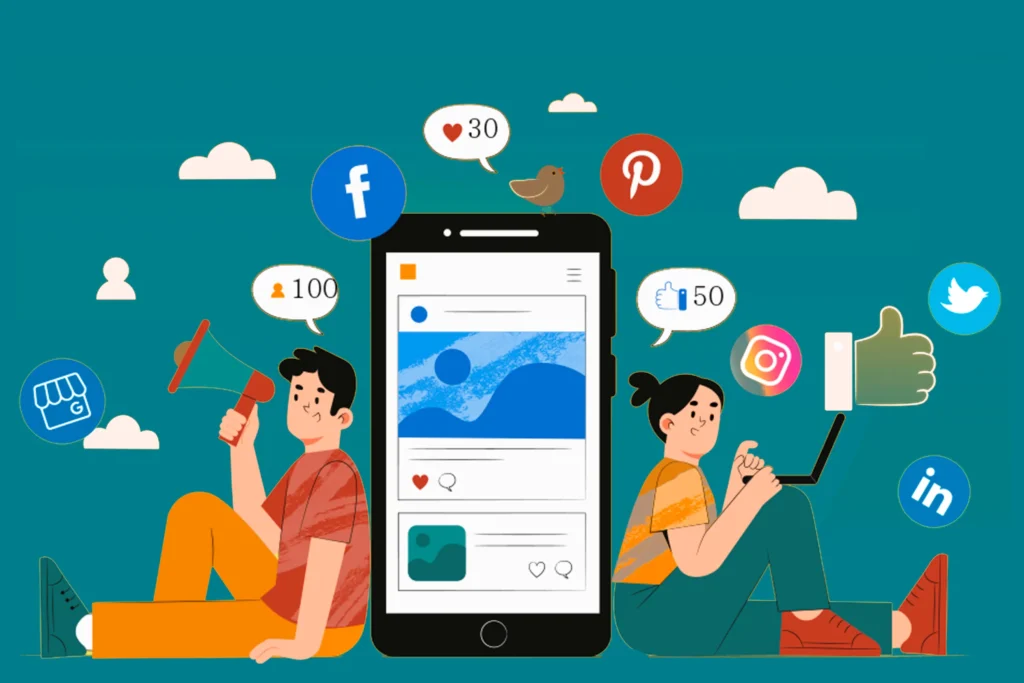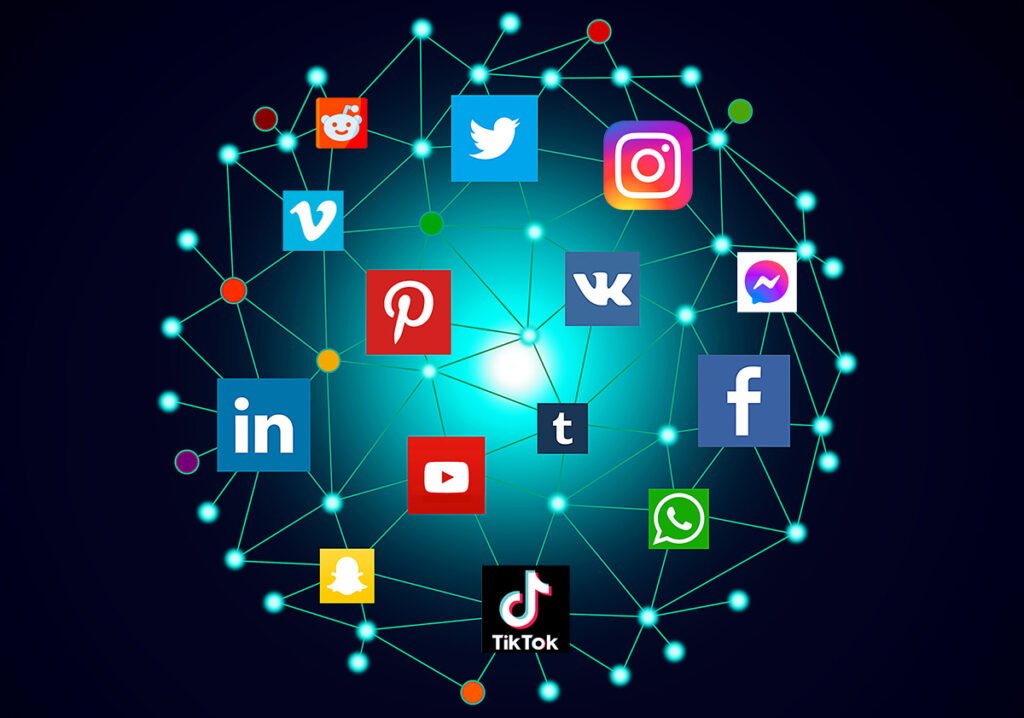Social Media Marketing (SMM) is a digital marketing strategy that involves leveraging social media platforms to connect with your target audience, build brand awareness, drive website traffic, and ultimately achieve your business goals. Here’s an overview of key components and best practices in social media marketing: social media marketing services in kerala
Goal Setting: Start by defining clear and specific goals for your social media marketing efforts. Common objectives include increasing brand awareness, generating leads, driving sales, fostering customer engagement, and building brand loyalty.
Audience Research: Understand your target audience’s demographics, interests, behaviors, and preferences. This information will help you tailor your content and messaging to resonate with your audience and drive engagement.
Platform Selection: Choose the social media platforms that are most relevant to your target audience and align with your business objectives. Consider factors such as the demographics of each platform’s user base, the type of content that performs well, and your resources for content creation and management.
Content Strategy: Develop a content strategy that aligns with your brand identity, goals, and target audience. Create a mix of content types, including informative posts, entertaining content, user-generated content, visuals (such as images and videos), and promotional messages. Consistency and authenticity are key to building trust and credibility with your audience.
Engagement and Community Management: Actively engage with your audience by responding to comments, messages, and mentions in a timely and authentic manner. Encourage conversations, ask questions, and solicit feedback to foster a sense of community and connection with your followers.
By implementing a strategic and data-driven approach to social media marketing, you can effectively engage with your target audience, build brand awareness, and drive meaningful results for your business.

Social Media Strategy
Define Your Goals: What do you aim to achieve with your social media presence? Whether it's brand awareness, lead generation, community building, or something else, clear goals will guide your strategy. Know Your Audience: Understand who your target audience is, their demographics, interests, and online behavior. This helps tailor your content to resonate with them. Choose the Right Platforms: Not all social media platforms are suitable for every business. Select the platforms where your audience is most active and where your content will perform best. Create Engaging Content: Develop a content plan that includes a mix of posts, such as informative articles, entertaining videos, engaging visuals, and user-generated content. Keep your content relevant to your audience and aligned with your brand identity. Consistency is Key: Maintain a consistent posting schedule to keep your audience engaged and build momentum. Consistency helps establish your brand presence and fosters trust with your audience. Interact and Engage: Social media is about building relationships. Respond to comments, messages, and mentions promptly. Engage with your audience by asking questions, running polls, and encouraging user-generated content. Utilize Visuals: Visual content tends to perform better on social media. Use high-quality images, videos, infographics, and other visual elements to capture attention and convey your message effectively.social media marketing services in kerala

Social Media Marketing Services in kerala
In Kerala, like in any other region, there are numerous social media services available to businesses and individuals. These services can range from social media management, content creation, advertising, influencer marketing, and analytics. Here are some examples of social media services you might find in Kerala: Social Media Management Agencies: These agencies handle all aspects of social media for businesses, including content creation, posting, engagement, and analytics. Content Creation Studios: These studios specialize in creating high-quality visual content such as images, videos, and graphics tailored for social media platforms. Digital Marketing Agencies: Many agencies offer comprehensive digital marketing services, which include social media marketing as a key component. Influencer Marketing Agencies: Influencer marketing is popular in Kerala, and there are agencies that specialize in connecting brands with local influencers for promotional campaigns. Analytics and Insights Providers: Some companies offer tools and services to track and analyze social media performance, providing valuable insights for optimizing strategies. Social Media Training and Consultation: Individual consultants or training institutes offer workshops and courses to educate businesses and professionals on effective social media strategies.social media marketing services in kerala
A social media platform is an online service or website that facilitates the creation, sharing, and exchange of user-generated content among individuals or communities. These platforms provide virtual spaces where users can connect with others, engage in communication, and interact with content in various forms.
User Profiles: Users typically create profiles that represent themselves on the platform. These profiles often include personal information, such as a bio, profile picture, and interests.
Content Sharing: Users can create and share various types of content, including text posts, images, videos, links, and status updates. This content can be shared publicly or with specific groups or individuals.
Engagement Tools: Social media platforms offer tools for users to engage with content and with each other. This includes features such as likes, comments, shares, reactions, and direct messaging.
Networking: Users can connect with friends, family, colleagues, and other users on the platform through features like friend requests, follows, and groups. This facilitates networking and community-building.
Discovery and Exploration: Social media platforms provide tools for users to discover new content, accounts, and communities based on their interests, preferences, and connections.
Privacy Settings: Users have control over the privacy settings of their accounts, allowing them to choose who can see their content and interact with them.
Examples of popular social media platforms include:
- Facebook: A platform for connecting with friends and family, sharing updates, and joining groups and events.
- Instagram: A photo and video sharing platform where users can post and discover visual content.
- Twitter: A microblogging platform for sharing short messages, links, images, and videos with followers.
- LinkedIn: A professional networking platform for building connections, sharing career-related content, and finding job opportunities.
- YouTube: A video sharing platform where users can upload, view, and interact with videos on various topics.social media marketing services in kerala
What Is Social Media Marketing (SMM)?
Social media marketing (also known as digital marketing and e-marketing) is the use of social media—the platforms on which users build social networks and share information—to build a company’s brand, increase sales, and drive website traffic. In addition to providing companies with a way to engage with existing customers and reach new ones, SMM has purpose-built data analytics that allows marketers to track the success of their efforts and identify even more ways to engage.
Within 18 years, from 2004 (when MySpace became the first social media site to reach one million users) to 2022, the dramatic growth of interactive digital channels took social media to levels that challenge even the reach of television and radio.1 At the start of 2023, there were 4.76 billion social media users globally—over 59% of the world’s population.2
DataReportal. “Global So
Sticky content is the marketing term for attractive content that engages customers at first glance and then influences them to purchase products and share the content.
Viral marketing is an SMM strategy that attempts to trigger the rapid spread of word-of-mouth product information—a very simple and inexpensive way to promote sales.
Earned media is a marketing term for brand exposure from any method other than paid advertising, e.g., customer-created content ranging from product reviews and recommendations to shares, reposts, and mentions.
Social media marketing has grown to include several techniques and strategies to engage users and market products and services. These include audience-targeted advertising, interactive chatbots, creating personalized experiences for customers online, social media influencers, and building an online audience.




The costs of social media advertising can vary widely depending on several factors, including the platform used, the ad format, the target audience, and the bidding strategy. Here's an overview of the key cost factors associated with social media advertising:
Platform-Specific Costs:
- Facebook and Instagram: Generally, the cost per click (CPC) ranges from $0.50 to $2.00, while cost per thousand impressions (CPM) can range from $5 to $10.
- Twitter: CPC typically ranges from $0.50 to $3.00, and CPM can be around $6.46.
- LinkedIn: Known for being more expensive, CPC can range from $2 to $7, and CPM can be $6 to $9.
- Pinterest: CPC usually ranges from $0.10 to $1.50, and CPM can be around $2 to $5.
- Snapchat: CPM can range from $2.95 to $8.34, while CPC might be around $0.58.
Ad Format Costs:
- Text and Image Ads: Generally cheaper than video ads. For example, a static image ad on Facebook might cost around $0.50 per click.
- Video Ads: Tend to be more engaging but can also be more expensive. Video ads on Facebook might have a CPC of $0.10 to $0.30 but could have a higher CPM due to higher engagement rates.
- Carousel and Slideshow Ads: Often used for showcasing multiple products or features, these can be more cost-effective per engagement due to higher interaction rates.
Target Audience:
- Demographic and Interest Targeting: More specific targeting (e.g., niche interests, small geographic areas) can increase costs due to a more competitive bidding environment.
- Broad Targeting: Generally less expensive but might result in lower engagement if the audience is not well-aligned with the product or service.
Bidding Strategy:
- Manual Bidding: Allows advertisers to set their own maximum CPC or CPM, offering control over costs but requiring careful management.
- Automatic Bidding: The platform optimizes bids to achieve the desired outcome, such as maximizing clicks or conversions, which can sometimes result in higher costs but better performance.
Campaign Objective:
- Brand Awareness: Often priced by impressions (CPM), which can be cheaper overall but with a focus on reach rather than direct action.
- Conversions: Typically more expensive due to the focus on driving specific actions (e.g., purchases, sign-ups), often using a cost-per-action (CPA) model.
- Engagement: Aimed at likes, shares, and comments, these can have a variable cost depending on the engagement quality and volume.
Ad Duration and Timing:
- Seasonal Demand: Costs can spike during peak advertising seasons (e.g., holidays, Black Friday) due to increased competition.
- Ad Duration: Longer campaigns might benefit from lower average costs due to optimization over time, while short, high-impact campaigns might incur higher costs.
Ad Quality and Relevance:
- Quality Score: Platforms like Facebook and Google reward high-quality, relevant ads with lower costs. Ads with high engagement rates and relevance can enjoy reduced CPC or CPM.
- Creative Quality: Engaging and well-designed ads often perform better, potentially lowering costs through higher engagement rates and better ad placements.
Understanding these cost factors can help businesses effectively budget and optimize their social media advertising campaigns to achieve their marketing goals.social media marketing services in kerala






